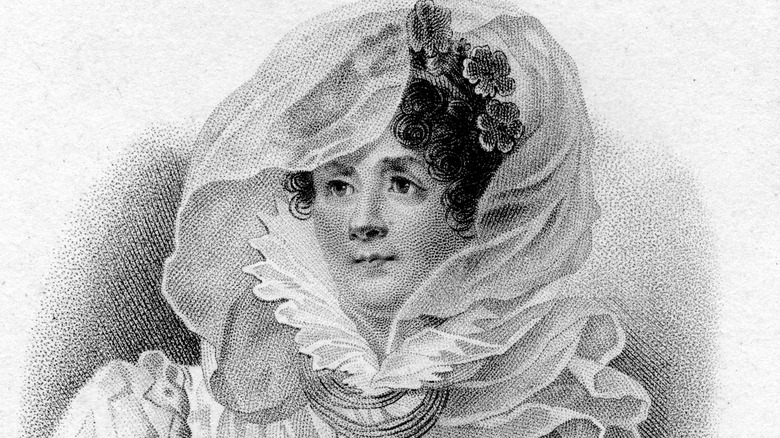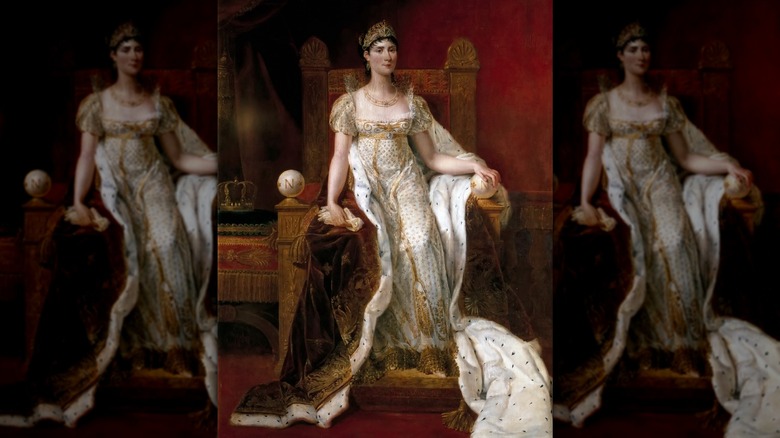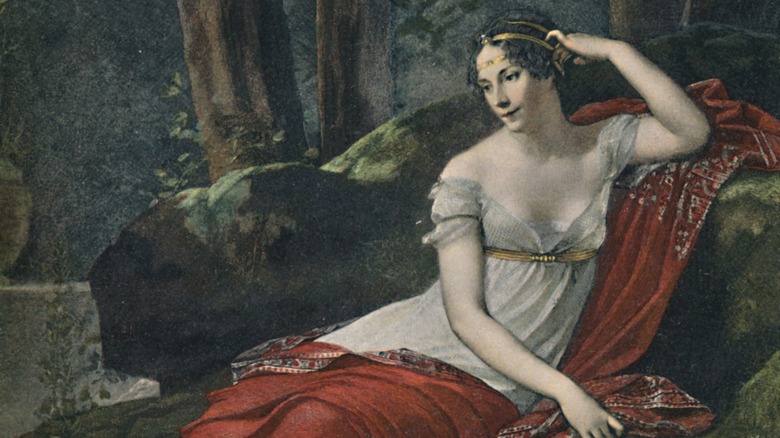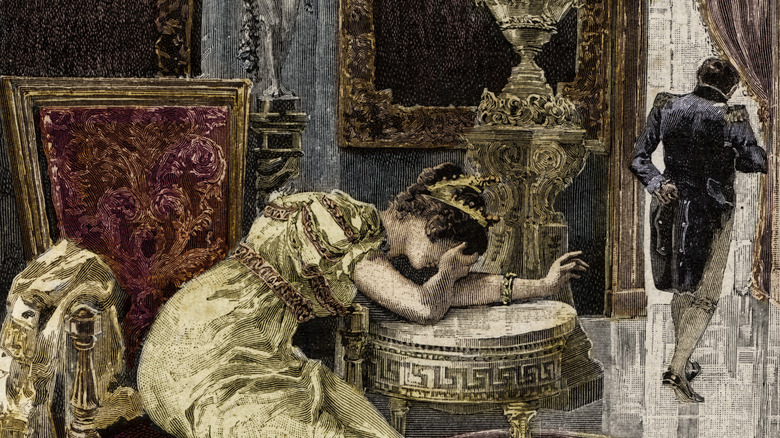The Lavish Spending Of Napoleon's Wife, Empress Josephine Bonaparte
The House of Bourbon was undone, in part, by the perception that the French court was a frivolous, unfeeling den of hedonistic spendthrifts. That image has clung most tightly to Marie Antoinette — unfairly, in most respects. Per the Smithsonian, the young queen was tenderhearted and generous. She did spend like there was no tomorrow, in part to escape the stifling conditions of the French court. But she was hardly the only one at court to do so. And if Antoinette did exceed the limits of propriety for a consort in her expenses, the queen was in the company of an empress.
According to The Telegraph, Josephine Bonaparte felt compelled to set her image apart from Antoinette's when she became empress in the wake of the French Revolution and Napoleon's campaigns. The Bonapartes both wanted to project a heroic image that looked more to ancient Rome than the lavish fairylands of Versailles, and Josephine even made herself an authority on Roman mythology through the building of new imperial jewels. But her and Napoleon's court became as extravagant as the old Bourbon one.
Monarchies and empires project splendor and wealth almost by nature, and the House of Bonaparte might have been expected to be particularly grand while establishing its legitimacy. But Josephine won a (somewhat exaggerated) reputation for personal excess not unlike her predecessor from the ancient régime. And if her wild spending didn't feed an existing sentiment that culminated in revolution, it would eventually help sunder her marriage to Napoleon.
Josephine blew through her annual allowance
Josephine Bonaparte, born Marie-Josephe-Rose Tascher in Martinique in 1763, was from a wealthy family but did not enjoy unlimited riches growing up (per PBS). Her family's estate was destroyed in a hurricane, and though Josephine or her sisters could marry to provide financial security, matchmaking was complicated by their limited education. Josephine's first marriage to Alexandre Francois de Beauharnais was an unhappy arrangement, and it ended with the stroke of the guillotine in 1789 during the French Revolution. When Napoleon and Josephine first met, she was supporting herself as a mistress.
In Napoleon, Josephine had a husband who offered support, a potentially glorious future, and passionate affection, which Josephine did not return in kind. Her infidelities aroused his anger, provoked affairs of his own, and damaged their marriage. Another strain came from Josephine's spendthrift ways (per the Foundation Bonaparte). Upon becoming empress, Josephine was given an annual 120,000-franc allowance for her household that was carefully managed to cover her official expenditures on charities, patronage, and upkeep (per Ernest John Knapton's "Empress Josephine"). But her personal allowance, at 360,000 francs a year, was regularly exceeded, and she had also wracked up debt while Napoleon was still First Consul.
Even after discounts regularly extracted by her husband, Josephine was a big spender. Some of this was for the court — per The Telegraph, she spent 25 million francs over six years to reshape the wardrobe and jewels of France. But much of it was on personal effects and careless generosity. Napoleon grumbled and occasionally attempted to implement economies, but to little avail.
She was a great patroness of horticulture and the arts
Against the unqualified image of Josephine Bonaparte as a wild spendthrift, Ernest John Knapton noted in "Empress Josephine" that her expenses were high for an ordinary woman but not excessive for a monarch. Her spending and debts were a minor dent at most in the annual budget of France. And where she put her money affected the character of the Bonaparte dynasty. Besides helping to set the Roman aesthetic sought by her husband, Josephine literally brought the seat of government into his hands, at least for a time. Malmaison, the dilapidated estate she bought and restored in 1799, was used for affairs of state between 1800 and 1802 (per the National Museum of the Château de Malmaison).
It was at Malmaison that Josephine, to Napoleon's horror, established an English garden, the foundation of her reputation as a great patroness of horticulture (per Longreads). Knapton quibbles with the label — he said Josephine had no scientific interest in gardening and pursued it with a passion as a hobby. Among her extravagances as empress was having plants from all over the world sent to her from her husband's campaigns. Per the Foundation Bonaparte, her garden was also filled with kangaroos, zebras, and other exotic animals.
The arts also benefitted from Josephine's generous patronage, and she loved sending commissioned portraits of herself to friends. But she supported many artists, among them Pierre-Joseph Redouté (per Galerie Botanique). Appropriately enough, Redouté specialized in painting flowers.
Josephine kept spending even after her annulment
Money and infidelity may have weakened the Bonapartes' marriage, but by 1807, they were most estranged by the lack of an heir. Per PBS, Napoleon long believed that their failure to have a child was his fault. But the birth of his mistress's child and the death of his designated heir (Josephine's grandson) led him to consider divorce. It didn't help Josephine's case that, while she was popular with the people and still loved by the emperor, she was hated by Napoleon's family (per the Foundation Bonaparte). In 1809, Napoleon told Josephine that he needed a divorce. She was distraught, but she agreed.
Josephine kept the title of empress, her home at Malmaison, and the affection and concern of her former husband. She also kept her spendthrift habits. Per The Telegraph, Josephine kept up a grand lifestyle that put her deeply into debt — a debt she was embarrassed to concede. To cover her expenses, she sold off many of the jewels she'd had made during her marriage, often through her children by her first marriage. The sales have complicated the research, preservation, and sale of imperial jewels from the Bonaparte dynasty.
Even after Napoleon's fall and exile, Josephine remained a beloved figure and successfully charmed Tsar Alexander I of Russia, who had helped to defeat her former husband. Per Longreads, when Josephine died in 1814, it was preceded by a typical display of extravagance: She dressed in rubies in case she had to receive the tsar. Per "Empress Josephine," she left behind debts of 3 million francs, which — subtracted from the 11 million inheritance she left for her two children — left more than 8 million.



